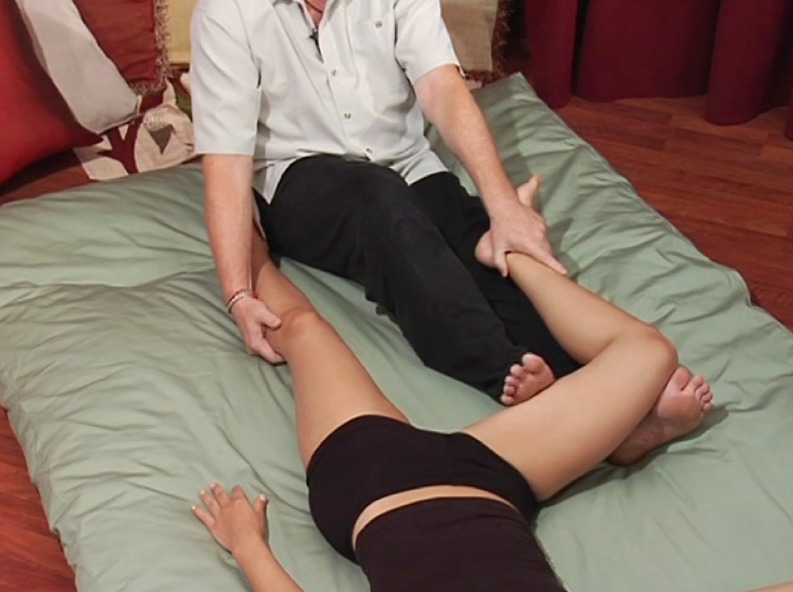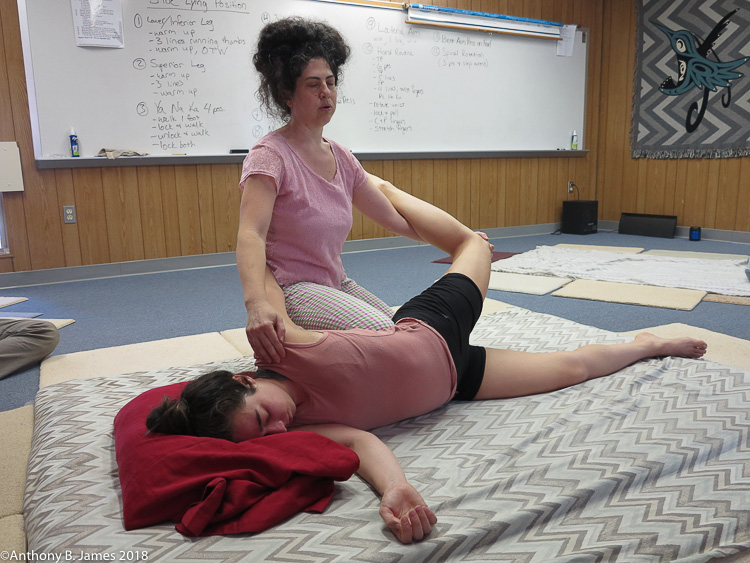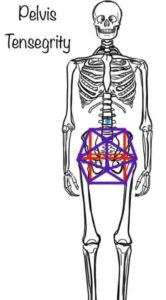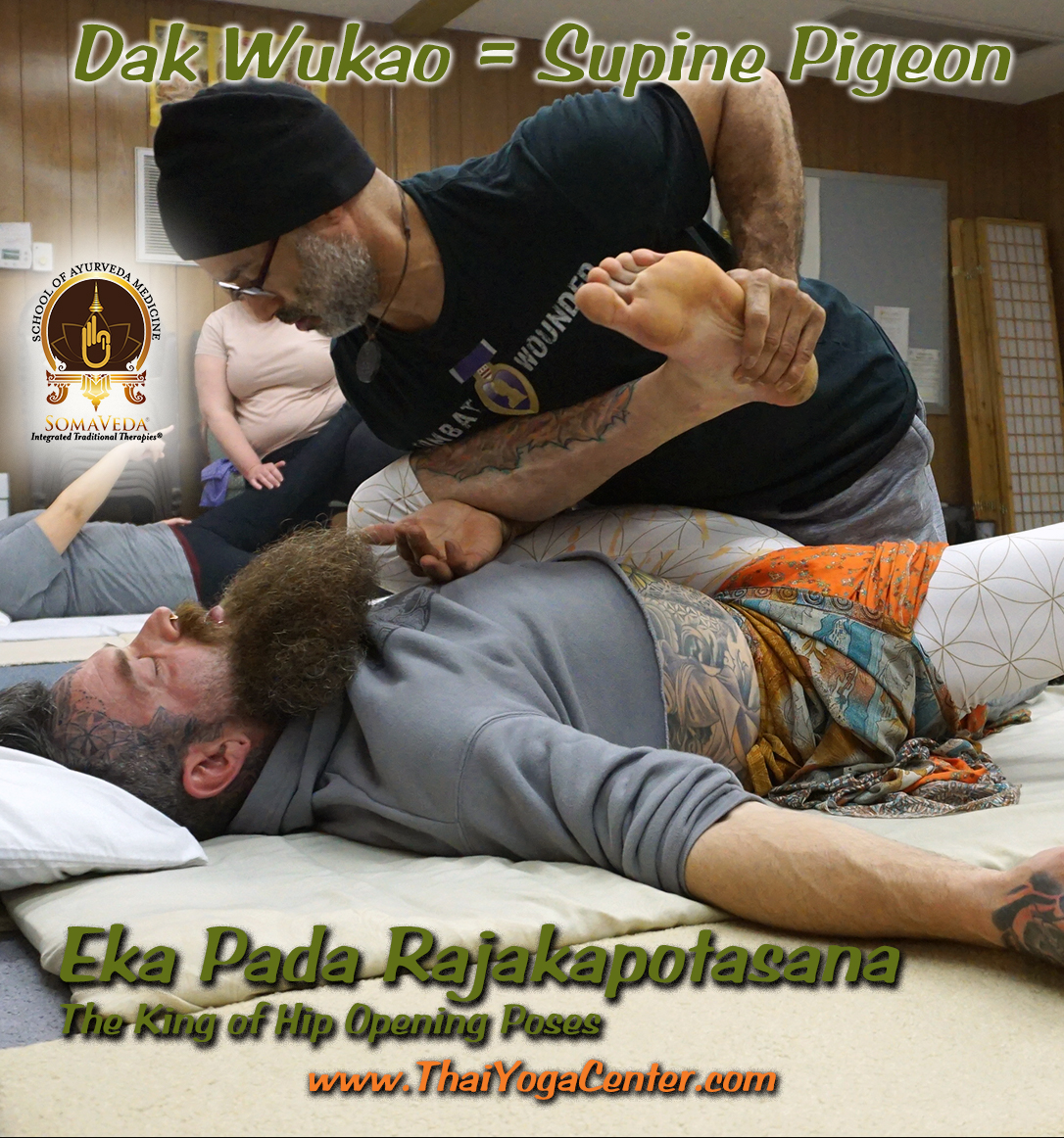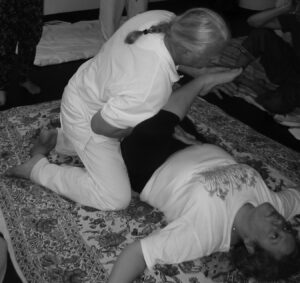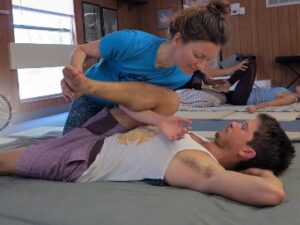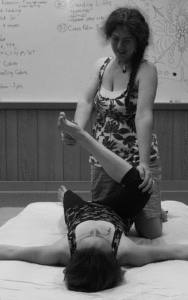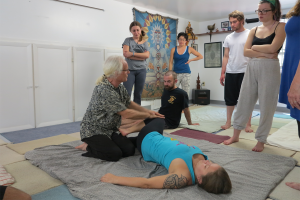How to fix Weak Posterior Chain issues with SomaVeda® Thai Yoga Therapy
by Ajahn, Dr. Anthony B. James
Your SomaVeda® Thai Yoga client still has hamstring, hip, and low back pain after sessions or the SomaVeda® Therapeutic Day program!
A review and commentary by Ajahn, Dr. Anthony B. James: Dean of the SomaVeda College of Natural Medicine
The reason may be a Weak Posterior Chain!
What is Weak Posterior Chain?
A weak Posterior chain is the structure and function of the posterior thighs (hamstrings), glutes, and Sacral/ Low Back. They are underdeveloped, injured, weak, uncoordinated, and, worse, subject to atrophy from lack of use. When I say lack of use, I mean it in every way. Too much sitting, short range of motion, and short load-bearing exercise to build and maintain healthy muscle and soft tissue, including connective tissue… Ligaments and tendons etc. This region may be ischemic and low in circulating oxygen, affecting the structure and function of the nerves and soft tissue, creating an inclination to spasm and further reducing the accessible range of motion. Hard to do Yoga when the muscles and tissues themselves are working hard, even at rest, to do the opposite!
Why? Client Compliance and lack of proper, effective home self-care!
What does this mean, and how to improve on long-term issues either with or after a SomaVeda® Thai Yoga program? Rome was not built in a day! As beneficial as a total seven-day+ SomaVeda® Thai Yoga Therapeutic Day Protocol or program is, it is NOT Magic! Many chronic pain issues develop over many years. They are further complicated by traumatic histories of accidents and injuries accumulated over time and complex with malnutrition and toxicities, years of inactivity and resulting atrophy, energy imbalances, and more. We eventually want to address these as they impact the specific clients’ pain and well-being, moving them toward recovery. However, today I want to bring attention to what the clients can and do have to do on their behalf! The SomaVeda® Thai Yoga technique I am focusing on today is the SOmaVedar Thai Yoga “YaNaKa” or “Push The Leg.” YaNaKa is the essential Thai Yoga technique, representing a three-joint traction and decompression technique. YaNaKa emphasizes the posterior leg lines or Thai Sen lines above the knee to the PSIS pelvis. The three joints affected are the ankle, knee, and pelvis. This is one of the very few techniques in any physical therapy system that can traction and decompress the knee… very important and helpful if there is inflammation, extra fluid, or swelling in the knee.
Watch the 159 Different YaNaKa & Push The Leg video to see the “Hands-On” Chirothesia corrections in our SomaVeda® kit.
We can do fantastic work. The issue always comes back to what is the patient/ client doing between sessions at home. How can the client/ patient comply with their recovery process by addressing some of the actual causes for their “Weak Posterior Chain” issues?
What the client does to support their progress towards reduced pain, pain-free living, or a free and accessible range of motion is vital. Even after a complete program and anywhere from 9 to 12 contact hours hands-on… this pales in comparison to the twenty-four/ seven lifestyle of the client for either excellent or ill.
All pain clients have a “Kapha Dosha” imbalance! No matter their diagnosis, “Vikruti,” elemental imbalance, or body type. How? Why? One of the critical indicators of a “Kapha Dosha” imbalance is IGNORANCE. Ignorance of how the client created the origin of the pain, the injury, the atrophy, the chronic inflammation, and the poor medical or therapeutic choices may not only help but also worsen the pain. This includes delegating responsibility for their healing and wellness to an institutional and corporate medico who proscribed various drugs, steroids, opiates, etc., for “pain management,” but which in the long term did not prove helpful.
Where the SomaVeda® Thai Yoga Therapeutic Program ends, the client’s self-work and compliance with the therapist counseling and recommendations begin! Yes, the clients need help and need therapeutic programs and interventions. However, they also need guidance in self-maintenance and home practices to educate them in support of their compliance routines…
The SomaVeda® T.A.E.L.R. (SomaVeda® Tool Assisted Energy Line Release) protocol extends the hands-on Chirothesia or manual therapeutic hands-on healing ministry using adjunct therapies and “tools.” One of the most important tools is to educate the client on what they can control, contribute and effectively do at home for themselves as the partner in the therapy.
Consider: Weak Posterior Chain?
More than these? Consider:
- Lack of Isometric Strength
- Walking with discomfort
- Hips locking up
- Bad posture leading to injury
- Trouble Sleeping
- Sluggishness in day-to-day life
- Rounded Shoulder
- Tight Hips
- Compromised Immune System
- “Anerobic Lactic Threshold” and why it’s crucial.
- Loss of sexual performance
- Lack of Explosiveness in Yoga practice, the gym, sports, and or Martial Arts
It’s not enough to know the client’s needs to do their “homework” and self-care; they need proper and sustained, detailed guidance on what to do and how to do it.
You won’t be with them at home, so we need a home study program that targets the issue. You, the SomaVeda® Thai Yoga Certified Practitioner, Therapist, Minister, or Physician, do your significant part. Refer your client (also yourself if you’re with chronic pain!) to the “Ground Control Program” for a fantastic program.
Please take a moment to read this critical sponsored message from the “Ground Control” Program.
Have you heard about Weak Posterior Chain?
Your Posterior Chain…
…stabilize your trunk and spine during movement and sitting
…allow you to bend your hips and legs towards your chest
…support your internal organs
…is connected to your diaphragm, enabling you to walk and breathe.
In other words, your posterior chain directly influences your fight or flight response!
The solution? Train Like a Jiu-Jitsu Black Belt! I am 17, dressed in my Gi, competing as a Black Belt in the Seishin Kai Jiu-Jitsu Competitions!
Most of you know I hold Black Belt Rank in Martial Arts and an equivalent in M.A. that does not use the belt system, such as Thai Muay Boran and Krabri Krabong. Click Here to see my Martial Arts Bio… I also hold Black Belt Rank in Go Budo Jiu-Jitsu. Jiu-Jitsu training is related to Judo but with a much wider variety of techniques and training methodologies. Jiu-Jitsu training has the perfect solution to the “Weak Posterior Chain.” I have found an excellent 12-weak HOME STUDY/ HOME Practice Course that is helping thousands of athletes overcome these physical limitations. Do not be intimidated by my reference to “Athletes.” Trust me when I say What Works for Athletes Will Work For You!
Take the challenge to restore the structure and function yourself, or refer your clients using the link below. Let me know if you need this link in an email, and I can forward it separately! Cheers, Ajahn Dr. James.
Suppose the posterior chain gets tight and weak. In that case, it can be a real pain, but working specific muscles and doing certain exercise combinations provide easy fixes for the “At-Home” Compliance and personal self-help program.
So… If you experience…
low back pain
hip pain
stiffness
pain while walking or moving
lack or loss of range of motion in your Posterior Chain (Hamstrings, Gluts, Sacral/ Low Back area)
shortness of breath
You need to start undoing some of the damage done to your body and start helping the body to heal itself naturally.

